Dec 24 2013
Protons and neutrons, the particles in an atomic nucleus, are made of smaller pieces called "quarks." Some types of quarks can form particles that exhibit surprising behaviors. Mark Mattson, Ph.D., assistant professor-research, and Paul Karchin, Ph.D., professor, from Wayne State University's Department of Physics and Astronomy in the College of Liberal Arts and Sciences, led a large collaborative effort of physicists at the Fermi National Accelerator Laboratory (Fermilab) in Illinois reporting a bizarre "social" behavior of particles containing "charm" quarks: an observation of "charm mixing." The result was published this month in Physical Review Letters, the highly-regarded journal for particle physics.
 The decay of the D*+ into a D0 and a soft (low-momentum) pion. The D0 then decays into a negative kaon and a positive pion. This is called a right-sign decay. Another decay mode called a wrong-sign, which is very rare, can occur. In this mode, the D0 decays into a positive kaon and a negative pion. Credit: Paul Karchin, Wayne State University
The decay of the D*+ into a D0 and a soft (low-momentum) pion. The D0 then decays into a negative kaon and a positive pion. This is called a right-sign decay. Another decay mode called a wrong-sign, which is very rare, can occur. In this mode, the D0 decays into a positive kaon and a negative pion. Credit: Paul Karchin, Wayne State University
Since the discovery of the charm quark in 1974, physicists have postulated a rare process in which a charm particle spontaneously changes into its antiparticle. Evidence for this unique behavior was uncovered more than three decades later by experiments in the US and Japan. However, conclusive observation did not emerge until this year from the CERN laboratory in Switzerland and Fermilab in the U.S.
Mattson and Karchin worked closely with team co-leaders from Fermilab and the University of Siena in Italy. Robert Harr, Ph.D. and Alexey Petrov, Ph.D., professors of physics and astronomy at Wayne State, served as team advisors.
The charm mixing that has been observed could be due solely to known elementary particles but may also indicate the presence of previously undiscovered particles and force carriers. Future measurements with improved precision and refined theoretical interpretation may elucidate the puzzle of why particle matter in the universe overwhelmingly dominates over antimatter.